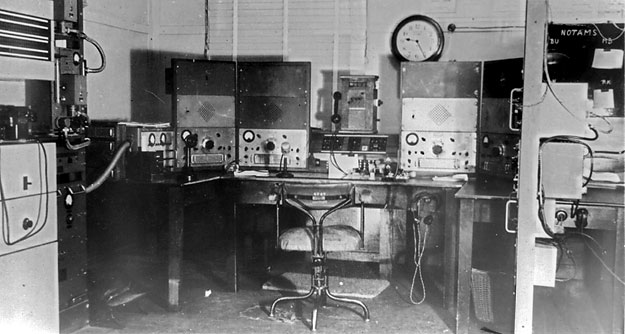
This
photograph shows the operator's position at Bundaberg Aeradio, c.1954. On the
desk can be seen four Kingsley AR7 HF receivers, which were standard equipment
in many Aeradio stations of the time. The second rack from the left is thought
to contain an ex-USAAF TA2J/24 HF receiver whilst the rack at far right is thought
to contain an ex-USAAF BC639 VHF receiver and associated power supply. VHF radio
was introduced in Australia in 1949.
Bundaberg was an RAAF aerodrome during the Second World War, housing 8 Service Flying Training School using Avro Ansons. Elements of the Netherlands East Indies Air Force were also based at Bundaberg, and both the RAAF and NEIAF were still operating when DCA assumed responsibility for the aerodrome and Aeradio station in June 1946.
Initially Aeradio used ex-RAAF transmitters and AR7 receivers, however after a few years the transmitters were replaced by an Standard Telephones and Cables (STC) CM1 transmitter located remotely.
When Bundaberg Aeradio opened in 1946, the next Aeradio station to the north was Rockhampton and to the south, Brisbane/Archerfield. Radio equipped aircraft were handed from station to station at mutually agreed points: Flight Information Areas (FIAs) with defined boundaries did not then exist. The term 'free airspace' was used to describe airspace that was not controlled, but this term disappeared in the late '50s as other terms such as 'OCTA' (Outside Controlled Airspace) won acceptance. Click here to download a film clip of a 1950s aircraft position report.
Click here to see a photo of a typical aircraft radio installation of the period
Much of this information is sourced from Bundy: Over and Out by Ken Cross, held in the CAHS archive.
Click here to see the next in our Bundaberg Aeradio/Flight Service series
(Photo: CAHS collection)
Back
to the main Air Traffic Services
index
If
this page appears without a menu bar at top and left, click
here